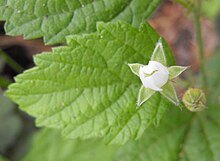Rubus leucodermis
| Rubus leucodermis | |
|---|---|

| |
| var. bernardinus | |
| Scientific classification | |
| Kingdom: | |
| (unranked): | |
| (unranked): | |
| (unranked): | |
| Order: | |
| Family: | |
| Genus: | |
| Subgenus: | |
| Species: | R. leucodermis
|
| Binomial name | |
| Rubus leucodermis | |
| Synonyms[1] | |
| |
Rubus leucodermis, called white bark raspberry [2][3][3][4] is a species of Rubus native to western North America, from Alaska south as far as California, Arizona, New Mexico, and Chihuahua.[5][6][7][8][9]
Rubus leucodermis is closely related to the eastern black raspberry Rubus occidentalis. The name leucodermis means "white skin," referring to the white appearance of the stems because of a thick waxy coating on the surface.[8]
Rubus leucodermis is a deciduous shrub growing to 0.5–3 m tall, with prickly shoots. While the crown is perennial, the canes are biennial, growing vegetatively one year, flowering and fruiting the second, and then dying. As with other dark raspberries, the tips of the first-year canes (primocanes) often grow downward to the soil in the fall, and take root and form tip layers which become new plants. The leaves are pinnate, with five leaflets on leaves' strong-growing stems in their first year, and three leaflets on leaves on flowering branchlets with white and infrequently light purple flowers. The fruit is 1–1.2 cm diameter, red to reddish-purple at first, turning dark purple to nearly black when ripe.[10] The fruit has high contents of anthocyanins and ellagic acid.[2][3][8]
The fruit is the basis of blue raspberry flavor, a popular flavor for candy, syrups and other sweets.[11]
It is a variable species, and forms natural hybrids with other species in subgenus Idaeobatus. Three varieties are recognized:[4]
- Rubus leucodermis var. leucodermis - Alaska to Chihuahua
- Rubus leucodermis var. bernardinus Jepson - southern California
- Rubus leucodermis var. trinitatis Berger - southern California
See also
- Rubus occidentalis, the commercial black raspberry
- Rubus niveus and Rubus coreanus, related Asian species
References
- ^ Tropicos, Rubus leucodermis Douglas ex Torr. & A. Gray
- ^ a b "Jepson Flora Project: ''Rubus leucodermis''". Ucjeps.berkeley.edu. Retrieved 2012-08-27.
- ^ a b c "Plants of British Columbia: Rubus leucodermis';". Linnet.geog.ubc.ca. 2011-07-22. Retrieved 2012-08-27.
- ^ a b "NCRS: USDA Plants Profile: ''Rubus leucodermis''". Plants.usda.gov. Retrieved 2012-08-27.
- ^ John H. Wiersema. "Germplasm Resources Information Network: ''Rubus leucodermis''". Ars-grin.gov. Retrieved 2012-08-27.
- ^ Biota of North America Program 2014 county distribution map
- ^ Calflora taxon report, University of California, Rubus leucodermis Torrey & A. Gray, White Stemmed Raspberry, western raspberry, white bark raspberry
- ^ a b c Flora of North America Rubus leucodermis Douglas ex Torrey & A. Gray, 1840.
- ^ SEINet, Southwestern Biodiversity, Arizona chapter photos, description, partial distribution map
- ^ Pojar, Jim; Andy MacKinnon (2004). Plants Of The Pacific Northwest Coast: Washington, Oregon, British Columbia & Alaska. Lone Pine Publishing. p. 77. ISBN 978-1-55105-530-5.
- ^ "Rubus Leucodermis - Exoplantus". exoplantus.fr (archived August 23, 2011). Archived from the original on August 23, 2011. Retrieved January 10, 2014.
{{cite web}}: Unknown parameter|deadurl=ignored (|url-status=suggested) (help)
External links
- Calflora: Rubus leucodermis (Western raspberry, White bark raspberry, White stemmed raspberry)
- Jepson Manual eFlora (TJM2) treatment of Rubus leucodermis
- USDA Plants Profile for Rubus leucodermis (whitebark raspberry)
- UC Photos gallery: Rubus leucodermis
- Rubus
- Berries
- Flora of the Northwestern United States
- Flora of the Southwestern United States
- Flora of Northwestern Mexico
- Flora of Alaska
- Flora of British Columbia
- Flora of California
- Flora of New Mexico
- Flora of the Sierra Nevada (U.S.)
- Flora of the Cascade Range
- Natural history of the California Coast Ranges
- Natural history of the Transverse Ranges
- Plants described in 1840
- Garden plants of North America
